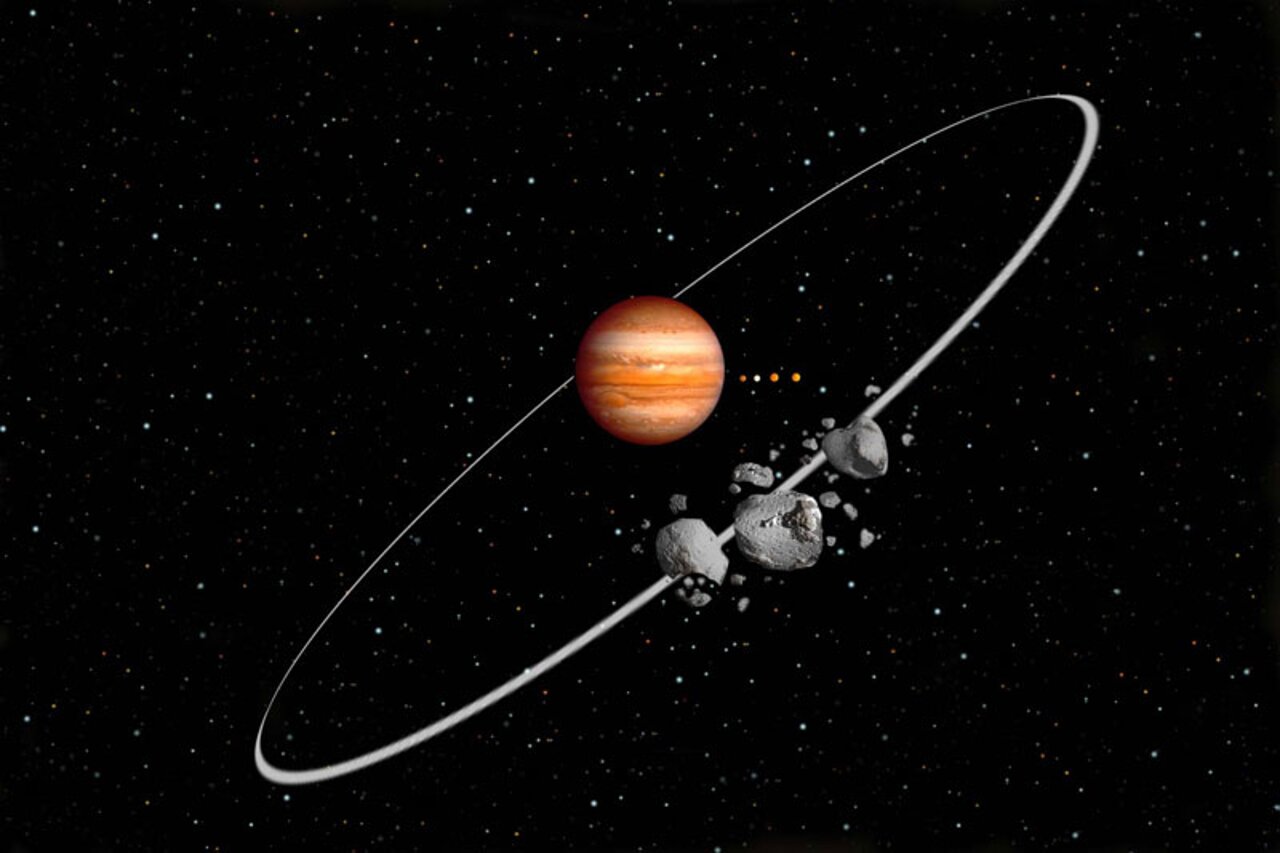Waltzing Irregular Satellites Around Jupiter and Saturn
May 4, 2004

Gemini North Near Infrared Imager (NIRI) observations have confirmed that many of the "irregular" satellites around Jupiter and Saturn share a common ancestry.
All the known planets of the solar system have moons, except for Mercury and Venus. Out in the realm of the gas giants large numbers of little worlds swarm around Jupiter, Saturn, Uranus, and Neptune. The "regular" satellites (often the largest and brightest) go around their planets in a prograde direction (the same direction as all the planet orbits around the Sun). They probably formed in planetocentric disks with nearly circular prograde orbits close to the equatorial plane of their planets. But the gas giants also have a surprisingly large retinue of "irregular" satellites (smaller and fainter) on highly inclined and eccentric orbits, both prograde and retrograde. Their "chaotic" orbits suggest that these small worlds formed outside circumplanetary disks and were captured by gravitational influences.
Irregular satellites are fascinating objects because of their complex histories. During the early formation period of the solar system about 4.5 billion years ago asteroid-like objects in heliocentric orbits were likely temporarily captured, for 10 to 100 orbits around the gas giants, collided, fragmented and became irregular satellites of these planets for a time. This interplanetary ballet suggests that some of the irregular satellites are recycled back into heliocentric orbits after relatively long visits at the giant planets. However many of the fragments became permanent members of the planet’s family of satellites, but were left in "weird" orbits with high inclinations or possible retrograde motions, coupled with high eccentricities.
We know that there are "families" of irregular satellites that have common dynamical properties, sort of like swarms of bees flying together. What we want to know is: did they all come from the same parent captured asteroid? Recent studies have found that the optical colors of each family member were similar to those of other objects in the family. Different families (or swarms) have different colors, betraying different surface properties and bodies of origin.
Measuring physical properties like the surface colors of satellites helps us to understand the origin of the irregular satellites. Astronomers Tommy Grav and Matthew J. Holman of the Harvard-Smithsonian Center for Astrophysics have conducted such a study, and their results appeared in the April 20, 2004 issue of The Astrophysical Journal. To do their survey, the authors observed 10 Jovian and 4 Saturnian irregular satellites using the Near Infrared Imager (NIRI) on the Frederick C. Gillett Gemini North Telescope in February 2003.
Why Infrared?
Observing in the infrared is a much better way to distinguish surface types. It is possible that satellites have the same color in the optical but different colors in the infrared, so you might be "tricked" into thinking that you are seeing a family. In reality they are all originate from different places.
Imagine two soccer teams showing up to a match, and wearing the same color shirts. You might think they are all the same team and that they came from the same country or origin. However, if you look at them in the infrared you can see that the two types of shirts look different, maybe because they were made with different dyes or fabrics. Then you can distinguish between the two teams. In this case, all the players—the irregular satellites—are on the same team, and the Gemini NIRI infrared observations confirm this. This is an important check, since there are many asteroids that have the same color "jerseys" in the visible but look different in the infrared. The homogeneous colors of the families support the hypothesis that these families are indeed the remnants of larger progenitors that were captured and subsequently fragmented.
Grav and Holman also found the infrared colors of the Jovian and Saturnian families of irregular satellites to be consistent with those of asteroids found in the outer parts of the main asteroid belt between Mars and Jupiter.
More details can be found in the paper "Near-Infrared Photometry of the Irregular Satellites of Jupiter and Saturn", by T. Grav and M. J. Holman in The Astrophysical Journal, 605: L141-L144, 2004 April 20.
